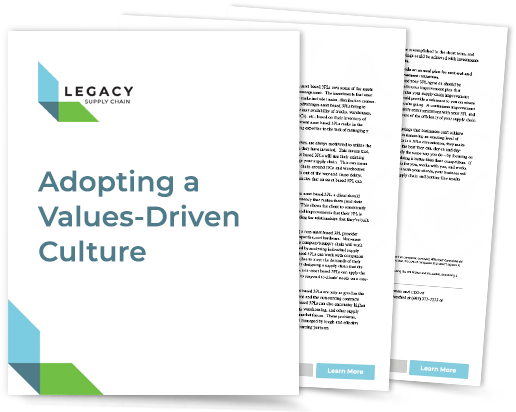Attracting and Retaining the Best Supply Chain Talent for Your Business

Supply Chain Talent Recruitment & Retention is A Key Influencer in Today’s Market.
Over the past several years there has been an increasing focus on supply chain talent. Popular topics of discussion center around which universities are training the best supply chain talent, how to spot the next generation of supply chain leaders and what makes supply chain talent a shrewd investment for a supply chain company. It’s a topic on everyone’s mind for good reason.
“Clearly, managing and growing talent is critical in today’s supply chain arena. Many project that the average growth rate for these leaders will far exceed the growth rate for other occupations in the coming years. Laying out a clear path for talented, upwardly mobile individuals will separate the winners from the losers in regards to driving efficiencies and meeting customer needs.”
—Andy Dishner, SVP of Client Solutions for LEGACY Supply Chain
With that in mind, how can you attract and retain the best supply chain talent to your business?
Have Your Company Culture In Place
This is where your hiring starts—and it’s not some box you can simply check off. If your company doesn’t have a strong culture and identity based on core values, you are already losing the game. We’ve talked a lot about supply chain culture, and this is one of the places where your culture really pays off.
Supply chain talent is in such high demand that the best in the field can take their pick of companies to work for. And with the continued growth of the supply chain industry, qualified supply chain professionals have the upper hand. In a field this competitive, the company with the best culture is where the best talent will begin their job searches.
Know Where The Best Supply Chain Talent Is Coming From
A recent Gartner study ranked the best Supply Chain Undergraduate University programs in the country. Coming in at number 3 (up from a previous rank of number 11), the University of Tennessee (UT) is eyed by many in the supply chain industry as the next big supply chain talent producer.
Steve Mangum, Dean of UT’s College of Business Administration, said in a press release on the college’s blog, “Through the leadership of our faculty and the capabilities of our students, we are helping companies across the nation design their supply chains for the future.” They are doing this through an increased focus on technology and leadership in the areas of scope, industry value and program size.
“We redesigned our supply chain curriculum and we continue to broaden it to reflect modern supply chain management,” said Mark Moon, head of the Department of Marketing and Supply Chain Management. The program, which previously focused primarily on logistics alone, now includes procurement, logistics and operations. “We now prepare our students to be conversant in all areas of contemporary supply chain management and proficient in their chosen area of specialization,” Moon said. “They are able to contribute immediately when they reach the workplace, and that makes our program extremely competitive.”
It’s important to understand the shift in supply chain education focus, and see which universities and colleges are ahead of the curve when it comes to training the next generation of supply talent.
Identify the Positions You Need Filled
Before you post your next job opening, make sure you are looking for people to fill the right positions. This involves taking a strategic look at where your weaknesses are, where growth is occurring and identifying the talent that will solve your current and future pain points.
It may be a no-brainer to know that you need a new Warehouse Manager when one gives their notice, but are you sure you have the right talent on your marketing team? What about your forecasting team? Tailor your team to your business model and goals, and don’t be afraid to create new, custom roles.
Don’t Overlook Middle Management Positions
The largest deficit in most supply chain companies is at the middle management level. Too often, the entry-level positions involve revolving door roles with high turnover rates, and career development energy is limited to executive-level positions. This leaves the middle management bereft of thoughtful cultivation.
On her website, SupplyChainShaman.com, Laura Cecere calls supply chain talent “The Missing Link,” noting that “efforts are focused on new-hire recruitment or mentoring for high-performance development for executive level positions. There are few companies that understand and have addressed the mid-management talent issue.” Don’t be one of the companies that make this common mistake.
Recognize And Develop The Talent You Already Have
Your supply chain team should have a thoughtful and strategic career development pathway. This helps not only in maintaining a strong company culture, but also empowers rising talent in lower-level positions to take on middle-management roles.
You may have great supply chain talent already on your team, but if you aren’t giving them a clear path to advance, they will go elsewhere.
Be Specific About The Skills And Experience You Need
Clearly articulating the skills and strengths you are looking for may sound frightfully simple but is an often-overlooked element of hiring. Job descriptions are copied and pasted without regular reassessment based on actual business growth and goals.
The best supply chain talent already knows what their strengths are, and they won’t waste their time with a company that isn’t looking for, and therefore won’t appreciate, their skills and experience.
Don’t Skimp On The Benefits
Once you have identified and successfully attracted the attention of the supply chain talent you need, you have a small window of opportunity to make your case before they move on to the next prospect.
By the time a prospective employee asks about a certain benefit, they already know what other companies are offering it. Be proactive. Know what benefits your competition is offering, and ask yourself what you can add to the package to make the difference in your favor.
Retain the Talent You Have Once You Get Them
Retaining the best supply chain talent might be the most difficult piece of this puzzle, because it is the hardest to implement at a sustainable level. More companies will offer hiring bonuses than will truly commit to great communication; more companies will have a polished benefits brochure than will have thought out a strong career development program.
This is where your company can really set itself apart. The aforementioned career development paths are one way to retain top talent. Another key element is transparency and communication. Make sure that if your team members have a complaint or suggestion for improvement, they have someone who will take their feedback seriously. And as we’ve said time and again, leadership starts at the top, with a strong commitment to core values. Put in the effort to maintain your values-driven culture, and the benefits will be great and long lasting.
Attracting and retaining the best supply chain talent is the key to getting ahead and staying ahead in today’s supply chain environment. Make sure you are taking the steps to succeed. If you don’t make sure that your company can get and keep the best talent, the next company will.
Get Insights. Stay Ahead.
Get the latest news and insights via email on warehouse improvement, transportation optimization, labor strikes and international shipping rate changes.Popular Posts
Search Posts
-
2024 Q1 Freight Landscape: Trends, Challenges, and Predictions
As the first quarter of 2024 comes to an end, here are some observations over the past few months as well as predictions about the trucking...
+ Read more -
Baltimore Bridge Impact Assessment – Update
Following the recent Baltimore Bridge collapse and subsequent port closures, we want to keep our customers informed about the situation and...
+ Read more -
Global Momentum Builds for Charge on Global Shipping Sector’s CO2 Emissions
A growing coalition of 47 countries, including key players like the European Union, Canada, Japan, and various Pacific Island nations, is...
+ Read more










